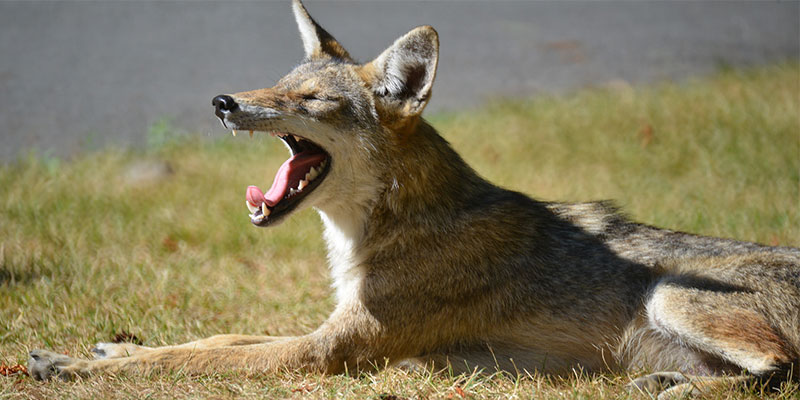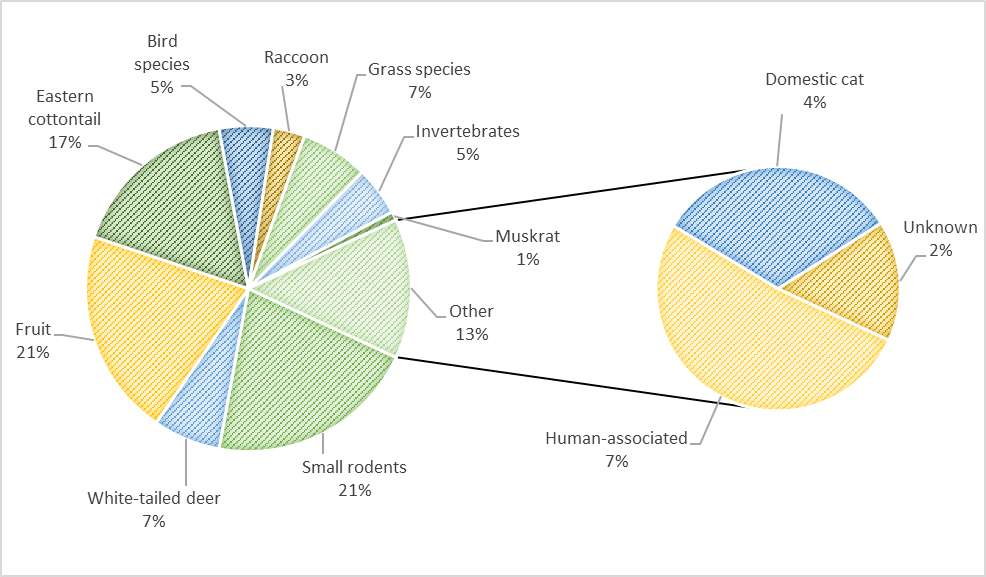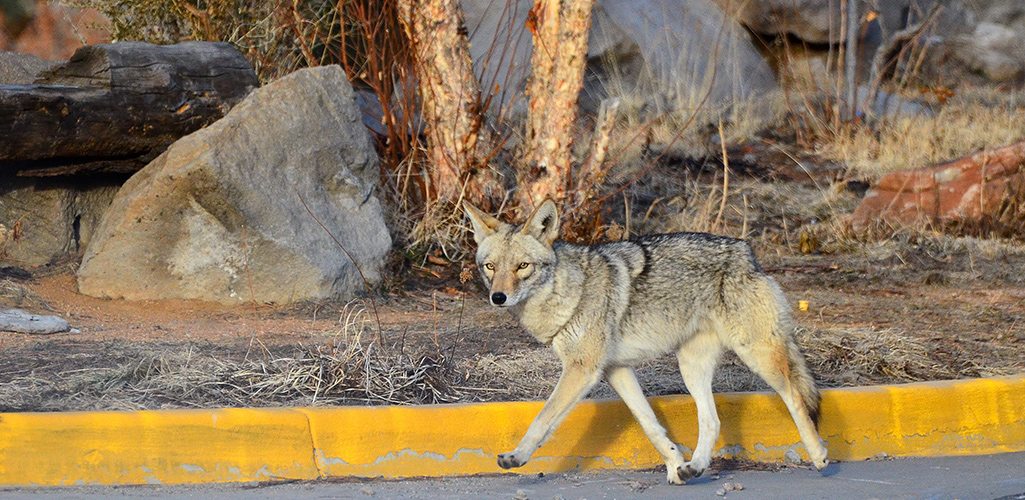Seeing coyotes in your backyard may make you feel uncomfortable especially if you have pets or small children in your family. Fear not! There is a way to share your neighborhood with coyotes and stay safe!
While the sight of coyotes may bother some people, they are a native species to North America and as urban development spreads out into more wilderness areas it is becoming more common to see coyotes in suburban and even urban areas. The characteristics that coyotes are known for (quick-thinking, evasive, and adaptable) are the same characteristics that have allowed them to habituate alongside people. Coyotes are opportunist omnivores and that means they can consume a variety of foods from meat to fruit (depending on what is available).
With coyotes finding it easier to live in the urban environment it is no surprise that people are becoming concerned about the role of coyotes as predators. Researchers are finding evidence that the urban environment is naturally selecting for coyotes that have different behavior patterns than coyotes that live in the wilderness (Gehrt, Anchor, & White, 2009). Coyotes are more suited for diurnal life, which means they are naturally more active during the day, but in urban environments coyotes are more active at dawn, dusk, and evening hours (Gehrt, 2007). The thought behind this switch is that it is easier for coyotes to survive during the hours where they can avoid being seen by people and can avoid being hit by cars. Seeing coyotes out in the middle of the day doesn’t necessarily mean there is something wrong with it.
But what does this mean for people? It means that we need to rethink how we act around urban coyotes. Yes, I said WE need to rethink how we act. This is because many human conflicts are the result of how we live. The urban environment favors intelligence and boldness in many animal species, including coyotes.
Why do people fear coyotes?

People often fear things when they have no personal experience to back up their understanding. It is also easy to fear something where they have had a negative experience or an uninformed experience. In the case of coyotes, if you have never seen a coyote but had only heard stories of coyotes eating people’s pets, it would be understandable to think that coyotes are a bad thing. People who have had livestock and/or pets killed by coyotes would understandably have a negative stance on coyotes since it is for personal reasons.
Even though coyotes have been known to eat pets (cats, small dogs, and others) research shows that cats make up only 1 - 13% of an urban coyote’s diet (Lukasik & Alexander, 2012; Morey, Gese, & Gehrt, 2007).
If coyotes aren’t living in neighborhoods specially to eat your cat, then what are they eating?


Studies have shown that, in the urban environment, rodents and rabbits are the primary diet of coyotes and represent almost half of their diet (Morey, Gese, & Gehrt, 2007; Lukasik & Alexander, 2012). This is why coyotes and other predators (like owls and bobcats) are so important to have around. Without predators, animals like rats and rabbits see a huge population increase and become a problem.

If coyotes rarely consume cats and dogs, do I still need to be concerned?

The short answer is yes, coyotes still pose a threat to your cats and dogs. The long-answer is yes and no, because while coyotes will prey upon cats and dogs when the opportunity presents itself, there are ways of protecting your pets from coyotes. It is important to be aware of coyotes and to understand how to keep your cats and dogs safe from coyotes.
Coyotes are naturally shy animals and typically avoid confrontation with people. They don’t want to put themselves in a position where there is a chance for their own injury since that could impact their ability to survive and reproduce. Coyotes typically only pose a threat towards pets and potentially small children. Statistically a small child is more likely to be harmed by a domesticated dog than by a coyote. However, since that risk is possible you should know how to keep your pets and family safe from coyotes.
While you personally may not be attracting coyotes to an area, here are some ways you can ensure that you are not adding to the problem:
Do not feed wild animals! This can be intentional (leaving food out with the direct intention of feeding wildlife) or unintentional (leaving your trash out unsecured or keeping cats outdoors). Either keep your trash in a secure location where coyotes and other animals cannot gain access to it, or use an animal-proof trash can. If you do this you will find that you are not only detering coyotes but you will also deter other animals like rats and raccoons from getting into your trash.
Never keep and raise a baby wild animal. No matter how cute it is, you are not doing the animal any favors by habituating it towards people. Without a fear of people, wild animals are at an increased risk of biting and attacking people out of conflict over food or territory.
Don’t allow your pets to roam free. Keep cats indoors or let them outside in a protected space and keep your dogs on leash in areas where there are coyotes.
If you are concerned about a coyote here are some things you can do:
Hazing
Video used with permission by Jefferson County Open Space [Jeffco Open Space]. (2017, May 5). Coyote Hazing Study Results. [Video File]. Retrieved from https://www.youtube.com/watch?v=E5I6vdgoKbM.
No, I don’t mean embarrassing the coyote into doing ridiculous things to gain access into a secret society. Coyote hazing refers to yelling and making a lot of noise to make people less enticing to be around…and yes, I am still referring to coyote hazing and not people hazing.
Seriously though, coyote hazing is a proven method that can give coyotes a bit of that healthy fear of people back.
One hazing method has you make yourself look larger than you really are by stretching your arms out and then yelling “GO AWAY COYOTE!” The important part of this method of hazing is that if the coyote runs a short distance but then stops and stares at you, you must move towards it and keep yelling until it leaves the area.
The Humane Society has additional guidelines about how to effectively and safely haze coyotes.
Attach coyote rollers to your fence
Video used with permission by Ry’s Connections. [Ry’s Connections]. (2016, August 1). What Are Coyote Rollers? [Video File]. Retrieved from https://www.youtube.com/watch?v=957yxi1E_kg&lc.
If you are lucky enough to already have a fully fenced in yard, this is an good solution to keeping your pets safe in your yard. This works by adding a roller bar to the top of your fence. When the coyote tries to go over your fence they won’t be able to grip the top and will roll right off.
Deter coyotes away from an area
- Wolf urine
- High frequency noises
Deterrents don’t always work for coyotes since they can become accustomed to the noise or smell if they realize they are not actually in any danger. If you are going to use a deterrent you must also follow-up with hazing or mix up the methods to stop the potential for any desensitization. The problem with using deterrents is that if you have any pets there is a potential for them to become upset as well.
Make your yard unappealing to coyotes
- Move around large objects in your yard
Coyotes have been shown to dislike novel objects in their territories and will often become discouraged from visiting a space if it is constantly changing.
Remove coyotes from an area
The problem with this option is that removing and reducing coyote populations from an area has never been successful for fixing coyote problems. Removing a single problem coyote may be deemed necessary but it is only a temporary fix. This is because coyotes live in family groups where only the head mating pair (the parents) of the group can breed. The head male (the father) aggressively enforces this by fighting off rival males and putting his sons in their place to ensure that he is the only one who breeds.
Coyote families are very loyal to one another and when either of the parents is killed, it causes disruption within the family group. Without a head male and female to enforce this breeding rule, the other family members will break off and form their own breeding groups. This means that by killing one of them, a chain of events ends up resulting in more coyote births, which is the opposite of what was intended.
Another unfortunate result of killing either of the parents is when you realize how coyotes learn social behaviors. Within the family group the parents teach their offspring to avoid humans and without this knowledge, many coyotes must learn the hard way to avoid humans.
A coyote that has lost its fear of humans can become a problem coyote, but unless the coyote attacks a person most animal control facilities will not act against the coyote. It is always a good idea to report any coyote activity if the coyote if becoming more aggressive.
Please go to our Facebook page and post your urban coyote stories and photos! Or if you have any comments about this article or if you have any suggestions for future articles feel free to comment on our Facebook page!
Additional resources:
Wisconsin Humane Society - Coexisting with Coyotes
Urban Coyote Initiative - What to do if you encounter a coyote while walking your dog
Coyotes As Neighbors: What to Know and Do, by CoyoteCoexistence.Com
The Humane Society of the United States - A Template Coyote Management & Coexistence Plan
References
Baker, R. O., & Timm, R. M. (1998). Management of conflicts between urban coyotes and humans in southern California. Hopland Research & Extension Center.
Gehrt, S. D. (2007). Ecology of coyotes in urban landscapes.
Gehrt, S. D., Anchor, C., & White, L. A. (2009). Home range and landscape use of coyotes in a metropolitan landscape: conflict or coexistence? Journal of Mammalogy, 90(5), 1045-1057.
Grubbs, S. E., & Krausman, P. R. (2009). Use of urban landscape by coyotes. The Southwestern Naturalist, 54(1), 1-12.
The Humane Society of the United States. (n.d.). Coyotes, Pets and Community Cats. Retrieved May 04, 2017, from http://www.humanesociety.org/animals/coyotes/tips/coyotes_pets.html
Lukasik, V. M., & Alexander, S. M. (2012). Spatial and temporal variation of coyote (Canis latrans) diet in Calgary, Alberta. Cities and the Environment (CATE), 4(1), 8.
Morey, P. S., Gese, E. M., & Gehrt, S. (2007). Spatial and temporal variation in the diet of coyotes in the Chicago metropolitan area. The American midland naturalist, 158(1), 147-161.
Robertson, D. (2011, February 5). Coyotes Don’t Eat Cats Very Often. Retrieved May 04, 2017, from https://lostpetresearch.com/2011/02/coyotes-dont-eat-cats-very-often/
Robertson, D. (2011, January 19). Observations of Coyote Predation on Cats. Retrieved May 04, 2017, from https://lostpetresearch.com/2011/01/observations-of-coyote-predation-on-cats/
Serieys, L. K. (2011). Coyotes. Retrieved May 04, 2017, from http://www.urbancarnivores.com/coyotes/
Banner photo - “Neighborhood Coyote” flickr photo by Larry1732 https://flickr.com/photos/larry1732/6925896565 shared under a Creative Commons (BY) license
